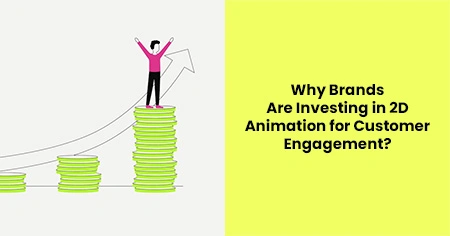That’s why many companies are investing in 2D animation for customer engagement. Animated content is eye-catching, easy to digest, and highly shareable, making it a powerful tool in today’s online world.
Animated videos for business help simplify complicated ideas and tell engaging stories. Whether for social media, websites, or ads, 2D animation makes content more compelling and memorable.
Animation is no longer just a secondhand option, but a smart investment for brands looking to stand out.
The Rise of 2D Animation in Marketing
Animation has helped advertising for almost 100 years.
In the early 1900s, silent films showed the first hand-drawn animations.
By the mid-1900s, brands like Kellogg’s and Michelin used animated mascots—like Tony the Tiger and the Michelin Man—to sell their products. These mascots made the products easier to remember and more relatable.
Back then, creators used frame-by-frame animation. It took a lot of time and cost a lot of money.
As marketing changed, animation changed too. The move from TV to digital platforms gave creators more ways to use animation.
New technology made animation faster and cheaper. Now, even small businesses can make high-quality animated videos.
Today, brands use 2D animation to connect with customers. It explains ideas clearly, keeps viewers interested, and works well on websites, social media, and ads.
Simplifying Complex Concepts
Many industries like SaaS, healthcare, and finance find it hard to explain their services simply.
2D animation helps by turning complex ideas into easy visuals, like how diagrams help in math.
Instead of using long explanations, animated videos use clear images, stories, and motion to explain things.
For example, Datum Creative Media made an explainer video for a SaaS company called ApolloMax. This company had trouble explaining its payment service to non-technical users.
Datum used 2D animation to turn confusing terms into a simple and interesting story with step-by-step visuals. The video helped people understand better, kept them engaged, and increased conversions. This showed how useful animation can be in marketing.
Boosting Audience Engagement
As mentioned earlier, 2D animation grabs and holds people’s attention by using movement, color, and storytelling.
Unlike still images, animated content stands out and keeps viewers watching longer.
Studies show that animated ads can get up to five times more
clicks than static ads.
[Source:
Animated Ads vs. Static Ads]
This leads to more conversions. Interactive content, including animations, gets 52.6% more engagement than static content.
On average, buyers spend 13 minutes on interactive content and only 8.5 minutes on static content.
These numbers explain why more brands use 2D animation to engage customers. When people interact more, marketing works better.
Cost-Effectiveness and Versatility
2D animation usually costs less than live-action videos. Live-action needs cameras, lights, actors, locations, and editing. These things add up fast.
But a small team can make 2D animation with software. It saves money and still looks good.
2D animation is also very flexible.
You can use it on websites, social media, emails, and presentations. You can easily change the size or update it without filming again. That also saves money.
That’s why many companies use 2D animation to connect with customers. It’s affordable, easy to update, and works well on many platforms.
Enhancing Brand Recall and Awareness: Honda’s Grrr
2D animated content helps brands stand out and stay in people’s minds. Eye-catching visuals, fun characters, and good stories make animation easy to remember.
Unlike stock footage, animation gives brands full creative control. This makes it easier to grab attention.
One strong example is Honda’s 2004 'Grrr' campaign.
The company used a 90-second animated ad to promote its i-CTDi diesel engines in the UK.
The ad showed a world where diesel engines were the bad guys, but Honda offered a better, quieter option.
The ad’s fun style and clear story boosted brand recognition.
As a result, Honda increased its UK sales by 35%.
Emotional Storytelling through Animation: BBC’s Mental Health Week
2D animation is more than just nice visuals.
It's also a strong way to tell stories. Brands use animation to connect with people emotionally.
When they mix characters, music, and voiceovers, they can tell stories that people remember.
For example, the BBC made an animated video for Mental Health Week.
It shows the fight against anxiety. The video focuses on school students and shows how anxiety can lower confidence and stop personal growth.
This animation helped people understand anxiety and feel more empathy.
Practical Steps for Integrating 2D Animation into Marketing Strategy
To start with 2D animation, pick content that needs visuals.
Good examples are product explainers, customer stories, or brand messages.
Choose topics that are complex, abstract, or emotional because animation handles them well.
Next, choose between hiring a professional studio or building your own team.
Studios work fast and know the craft. In-house teams give you more creative control and can save money over time.
Finally, track how your videos perform. Watch metrics like view time, click-through rate, and conversions.
These numbers show what works and help you improve your next campaign. This way, your 2D animation can truly boost customer engagement.
Future Trends in Animated Marketing Content
2D animation is changing quickly because of new technologies like AI, motion capture, and interactive media.
AI tools help speed up animation work. This makes it easier and cheaper for brands to create high-quality content.
Augmented Reality (AR) and interactive videos are also becoming popular. They let users enjoy animated content in a more personal and engaging way.
In the future, we will see more personalized animations. These will change based on a person’s data, behavior, or background.
AR will also let 2D animations interact with the real world through smartphones and wearable devices. This will make the experience even more immersive.
FAQs: 2D Animation for Customer Engagement
Why is 2D animation so popular?
2D animation is popular because it's visually engaging, easy to understand, and versatile across various platforms. It simplifies complex ideas and makes content memorable.
Is 2D animation in high demand?
Yes, 2D animation is in high demand as brands seek creative ways to engage audiences and communicate messages effectively across digital channels.
Is the 2D animation industry growing?
Yes, the 2D animation industry is growing rapidly due to advances in technology, increased demand for online content, and the need for cost-effective marketing solutions.
What are the benefits of 2D animation?








